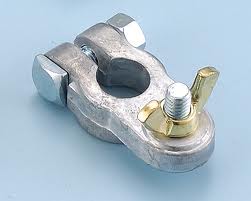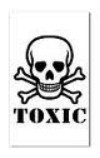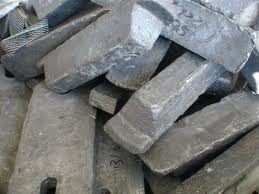Lead - (Pb)
Melting
Point: 621
Fahrenheit
\ 327
Celsius
Boiling Point: 3180 Fahrenheit \ 1749 Celsius

Properties: Lead is a very soft, dense, ductile, highly malleable, bluish-white metal. It is also counted as one of the heavy metals. Metallic lead is bright and silvery when freshly cut but the surface rapidly tarnishes in air to produce the commonly observed dull luster normally associated with lead. When melted into a liquid it has a shiny chrome-silver luster.
Lead is used in building construction, lead-acid batteries, bullets and shots, weights, as part of solders, pewter's, fusible alloys and as a radiation shield and as a metallic lubricant like when added to brass to reduce machine tool wear. Lead has the highest atomic number of all of the stable elements. It is used in applications where its low melting point, ductility and high density is an advantage. The low melting point makes casting of lead easy, and therefore small arms ammunition and shotgun pellets can be cast with minimal technical equipment. It is also inexpensive and denser than other common metals
Even with hundreds of common uses, Lead, at certain exposure levels, is a poisonous substance
to animals
as well as
for human
beings. It
damages
the
nervous
system and
causes
brain
disorders.
Excessive
lead also
causes
blood
disorders
in
mammals.
Like the
element
mercury,
another
heavy
metal,
lead is a
neurotoxin
that
accumulates
both in
soft
tissues
and the
bones.
Most
exposure
occurs
through
ingestion
or
inhalation.
Lead can
be
ingested
through
fruits and
vegetables
contaminated
by high
levels of
lead in
the soils
they were
grown in.
Soil is
contaminated
through
particulate
accumulation
from lead
in pipes,
lead
paint.
Inhalation
is the
second
major
pathway of
exposure,
especially
for
workers in
lead-related
occupations.
Almost all
inhaled
lead is
absorbed
into the
body, the
rate is
20–70% for
ingested
lead;
children
absorb
more than
adults so
precautionary
care for
proper
ventilation
must be
taken when
lead
smelting.
According
to Agency
for Toxic
Substance
and
Disease
Registry,
a small
amount of
lead (1%)
will store
itself in
bones and
the rest
will be
excreted
through
urine and
feces
within a
few weeks
of
exposure.
Children
have a
harder
time
excreting
lead. Only
about 32%
of lead
will be
excreted
by a child
substance
to animals
as well as
for human
beings. It
damages
the
nervous
system and
causes
brain
disorders.
Excessive
lead also
causes
blood
disorders
in
mammals.
Like the
element
mercury,
another
heavy
metal,
lead is a
neurotoxin
that
accumulates
both in
soft
tissues
and the
bones.
Most
exposure
occurs
through
ingestion
or
inhalation.
Lead can
be
ingested
through
fruits and
vegetables
contaminated
by high
levels of
lead in
the soils
they were
grown in.
Soil is
contaminated
through
particulate
accumulation
from lead
in pipes,
lead
paint.
Inhalation
is the
second
major
pathway of
exposure,
especially
for
workers in
lead-related
occupations.
Almost all
inhaled
lead is
absorbed
into the
body, the
rate is
20–70% for
ingested
lead;
children
absorb
more than
adults so
precautionary
care for
proper
ventilation
must be
taken when
lead
smelting.
According
to Agency
for Toxic
Substance
and
Disease
Registry,
a small
amount of
lead (1%)
will store
itself in
bones and
the rest
will be
excreted
through
urine and
feces
within a
few weeks
of
exposure.
Children
have a
harder
time
excreting
lead. Only
about 32%
of lead
will be
excreted
by a child
Also See> Health Effects
http://www.osha.gov/SLTC/lead/index.html
Lead has poor electrical conductivity when compared to most other metals. But this metal is highly resistant to corrosion, and because of this property, it is used to contain corrosive liquids (for example, sulfuric acid) and electrical terminals around corrosives. Because lead is very malleable and resistant to corrosion it is extensively used in building construction – for example in the external coverings of roofing joints.
Lead has been commonly used for thousands of years because it is widespread, easy to extract and easy to work with. It is highly malleable and ductile as well as easy to smelt.
Metallic lead does occur in nature, but it is rare. Lead is usually found in ore with zinc, silver and (most abundantly) copper, and is extracted together with these metals. The main lead mineral is galena (PbS), which contains 86.6 % lead by weight.
Production and consumption of lead is increasing worldwide. Total annual production is about 8 million tonnes; about half is produced from recycled scrap. More than half of the worldwide lead production (at least 1.15 million metric tons) is used for automobiles, mostly as electrodes in the lead–acid battery, used extensively as a car battery. At current use rates, the supply of lead is estimated to run out in 42 years. Some analyst have suggested lead could run out within 18 years based on an extrapolation of 2% growth per year
About Metal Spot Prices: The spot price of metals is based on paper contracts for delivery of tons of pure metal ingots. When you're not prepared to pay for and take delivery of tons of metal ingots, that spot price will quickly become a huge understatement of the real price of that metal. When you want to buy just a few pounds of Lead for example, you're looking at substantially higher prices. Moreover, once you own physical Lead ingots, make absolutely sure you never sell for the spot price of Lead. Because it's hard to get ingot grade Lead in physical form, you've got something special on your hands and make sure to extract the full value when you're selling and understand the reverse when buying.
spot price will quickly become a huge understatement of the real price of that metal. When you want to buy just a few pounds of Lead for example, you're looking at substantially higher prices. Moreover, once you own physical Lead ingots, make absolutely sure you never sell for the spot price of Lead. Because it's hard to get ingot grade Lead in physical form, you've got something special on your hands and make sure to extract the full value when you're selling and understand the reverse when buying.
Lead ingots are currently selling in the 4.00 - 6.00 dollar range per pound.
TheFoundryZone.com
Boiling Point: 3180 Fahrenheit \ 1749 Celsius

Properties: Lead is a very soft, dense, ductile, highly malleable, bluish-white metal. It is also counted as one of the heavy metals. Metallic lead is bright and silvery when freshly cut but the surface rapidly tarnishes in air to produce the commonly observed dull luster normally associated with lead. When melted into a liquid it has a shiny chrome-silver luster.
Lead is used in building construction, lead-acid batteries, bullets and shots, weights, as part of solders, pewter's, fusible alloys and as a radiation shield and as a metallic lubricant like when added to brass to reduce machine tool wear. Lead has the highest atomic number of all of the stable elements. It is used in applications where its low melting point, ductility and high density is an advantage. The low melting point makes casting of lead easy, and therefore small arms ammunition and shotgun pellets can be cast with minimal technical equipment. It is also inexpensive and denser than other common metals
Even with hundreds of common uses, Lead, at certain exposure levels, is a poisonous
 substance
to animals
as well as
for human
beings. It
damages
the
nervous
system and
causes
brain
disorders.
Excessive
lead also
causes
blood
disorders
in
mammals.
Like the
element
mercury,
another
heavy
metal,
lead is a
neurotoxin
that
accumulates
both in
soft
tissues
and the
bones.
Most
exposure
occurs
through
ingestion
or
inhalation.
Lead can
be
ingested
through
fruits and
vegetables
contaminated
by high
levels of
lead in
the soils
they were
grown in.
Soil is
contaminated
through
particulate
accumulation
from lead
in pipes,
lead
paint.
Inhalation
is the
second
major
pathway of
exposure,
especially
for
workers in
lead-related
occupations.
Almost all
inhaled
lead is
absorbed
into the
body, the
rate is
20–70% for
ingested
lead;
children
absorb
more than
adults so
precautionary
care for
proper
ventilation
must be
taken when
lead
smelting.
According
to Agency
for Toxic
Substance
and
Disease
Registry,
a small
amount of
lead (1%)
will store
itself in
bones and
the rest
will be
excreted
through
urine and
feces
within a
few weeks
of
exposure.
Children
have a
harder
time
excreting
lead. Only
about 32%
of lead
will be
excreted
by a child
substance
to animals
as well as
for human
beings. It
damages
the
nervous
system and
causes
brain
disorders.
Excessive
lead also
causes
blood
disorders
in
mammals.
Like the
element
mercury,
another
heavy
metal,
lead is a
neurotoxin
that
accumulates
both in
soft
tissues
and the
bones.
Most
exposure
occurs
through
ingestion
or
inhalation.
Lead can
be
ingested
through
fruits and
vegetables
contaminated
by high
levels of
lead in
the soils
they were
grown in.
Soil is
contaminated
through
particulate
accumulation
from lead
in pipes,
lead
paint.
Inhalation
is the
second
major
pathway of
exposure,
especially
for
workers in
lead-related
occupations.
Almost all
inhaled
lead is
absorbed
into the
body, the
rate is
20–70% for
ingested
lead;
children
absorb
more than
adults so
precautionary
care for
proper
ventilation
must be
taken when
lead
smelting.
According
to Agency
for Toxic
Substance
and
Disease
Registry,
a small
amount of
lead (1%)
will store
itself in
bones and
the rest
will be
excreted
through
urine and
feces
within a
few weeks
of
exposure.
Children
have a
harder
time
excreting
lead. Only
about 32%
of lead
will be
excreted
by a childAlso See> Health Effects
http://www.osha.gov/SLTC/lead/index.html
Lead has poor electrical conductivity when compared to most other metals. But this metal is highly resistant to corrosion, and because of this property, it is used to contain corrosive liquids (for example, sulfuric acid) and electrical terminals around corrosives. Because lead is very malleable and resistant to corrosion it is extensively used in building construction – for example in the external coverings of roofing joints.
Lead has been commonly used for thousands of years because it is widespread, easy to extract and easy to work with. It is highly malleable and ductile as well as easy to smelt.
Metallic lead does occur in nature, but it is rare. Lead is usually found in ore with zinc, silver and (most abundantly) copper, and is extracted together with these metals. The main lead mineral is galena (PbS), which contains 86.6 % lead by weight.
Production and consumption of lead is increasing worldwide. Total annual production is about 8 million tonnes; about half is produced from recycled scrap. More than half of the worldwide lead production (at least 1.15 million metric tons) is used for automobiles, mostly as electrodes in the lead–acid battery, used extensively as a car battery. At current use rates, the supply of lead is estimated to run out in 42 years. Some analyst have suggested lead could run out within 18 years based on an extrapolation of 2% growth per year
About Metal Spot Prices: The spot price of metals is based on paper contracts for delivery of tons of pure metal ingots. When you're not prepared to pay for and take delivery of tons of metal ingots, that
 spot price will quickly become a huge understatement of the real price of that metal. When you want to buy just a few pounds of Lead for example, you're looking at substantially higher prices. Moreover, once you own physical Lead ingots, make absolutely sure you never sell for the spot price of Lead. Because it's hard to get ingot grade Lead in physical form, you've got something special on your hands and make sure to extract the full value when you're selling and understand the reverse when buying.
spot price will quickly become a huge understatement of the real price of that metal. When you want to buy just a few pounds of Lead for example, you're looking at substantially higher prices. Moreover, once you own physical Lead ingots, make absolutely sure you never sell for the spot price of Lead. Because it's hard to get ingot grade Lead in physical form, you've got something special on your hands and make sure to extract the full value when you're selling and understand the reverse when buying.Lead ingots are currently selling in the 4.00 - 6.00 dollar range per pound.
TheFoundryZone.com